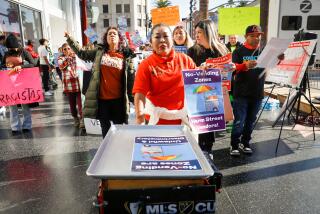Oxnard Panel Backs Greenbelt Agreement : Preservation: Planners’ action sends the policy to the council. Ventura has already endorsed effort to protect the 4,800 acres.
- Share via
The Oxnard Planning Commission narrowly recommended the city adopt a greenbelt agreement to preserve 4,800 acres of Oxnard and Ventura coastal farmland, breaking a tie vote the commission took last month.
Already backed by the Ventura Planning Commission and City Council, the proposed agreement will now be considered by the Oxnard City Council.
The greenbelt would cover 3,075 acres in Oxnard’s planning area and 1,711 acres in Ventura’s planning area, stretching from the Southern Pacific railroad tracks in Ventura south to 5th Street, and between Victoria Avenue and Harbor Boulevard.
By a 4-3 margin, the commission recommended that the cities of Oxnard and Ventura adopt Ventura County’s sixth greenbelt, a non-binding policy that would discourage either city from annexing and developing any portion of the greenbelt.
“I think this is one way of preserving the identity of the 10 cities within Ventura County,” said Planning Commission Chairman Ralph Schumacher before voting for the proposal.
Landowners in the affected area opposed the measure, arguing that it would add unnecessary restrictions to their property rights while not increasing farm profits.
Rex Laird, executive director of the Ventura County Farm Bureau, said a greenbelt agreement would trivialize farming by making it the public’s caretaker of open space.
“We feel it will take the industry from a position as the engine driving the economy of the county, to a hood ornament,” Laird said.
Commissioner Al Duff, who was absent June 3 when the other six commissioners deadlocked over the proposal, cast the decisive vote Thursday.
Duff, along with greenbelt supporters Schumacher and Commissioner Edward H. Flores, had served on the city’s General Plan Advisory Committee. After two years of weekly meetings, the 23-member committee had advised the city to adopt an Oxnard-Ventura greenbelt, which the council later incorporated as a goal in the 2020 General Plan, the city’s 30-year blueprint for development.
In his remarks Thursday, Duff emphasized the broad-based support for greenbelts on the advisory committee, which included representatives from farming, building and other business interests.
“I simply have to support the direction set by the General Plan,” Duff said.
The commission’s newest member, Commissioner Edward Castillo, joined the trio of commission veterans in support of the greenbelt.
Castillo, who was appointed to the commission in March, based his vote on what he said was the need for Oxnard to preserve its agricultural base. Referring to studies that showed a one-third decline in the amount of remaining farmland on the Oxnard Plain, Castillo said the greenbelt was needed to retain the revenues and jobs generated by the county’s largest industry.
“If we don’t have this greenbelt agreement in place, someone somehow will find a loophole around existing regulations” that restrict development, Castillo said.
Commissioners Dale Dean and Arthur J. Lopez again opposed the greenbelt agreement as unnecessary and overly restrictive, saying the land is sufficiently controlled by existing plans and zoning.
In his remarks, Dean took several swipes at the city of Ventura, questioning whether Oxnard should tie its future development plans to another city. “I still can’t see how Ventura has Oxnard’s best interest at heart,” Dean said.
Lopez asked the planning staff to investigate the propriety of a second vote on the greenbelt, suggesting that Schumacher asked for another vote only because he knew Duff would support the greenbelt.
Afterward, Schumacher denied calling for a second vote because it was very likely to go in his direction. “I wanted a recommendation to go to the City Council, be it negative or be it positive,” Schumacher said.
Under terms of the measure approved by the commission, both cities would review the greenbelt agreement every five years.
More to Read
Sign up for Essential California
The most important California stories and recommendations in your inbox every morning.
You may occasionally receive promotional content from the Los Angeles Times.










